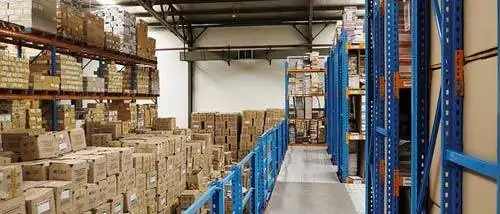Storage capacity / storage efficiency
The storage capacity is defined as the maximum number of load units that a warehouse can hold. It therefore also defines the actual performance capacity of a warehouse. Directly related to this are the size of the storage area, the height of the warehouse (usable space), the structure and turnover rate of the stock and, ultimately, the economic efficiency of a warehouse. Profitability is determined by many key figures that can be generated and analyzed by an enterprise resource planning system (ERP).
For cost reasons, a company always assumes the following situation: Storage means the intentional or unintentional interruption of the operational material flow. Storage therefore results in additional costs. In principle, the following applies: The storage capacity is calculated from the size of the designated main area of the warehouse and the usable space above it.
The following storage ratios/key figures are taken into account when determining the economic efficiency of a warehouse:
- Inventory intensity
- Order costs
- Excess stock
- Delivery rate according to customer segmentation
- Average stock level
- Inventory turnover rate
- Average storage duration
- Inventory interest rate
- Stock range/readiness for delivery
- Stocking rate
- Stock utilization rate
- Degree of readiness to deliver
- Capital commitment
- Key figures for means of transport utilization
- Supplementary descriptive warehouse parameters
Important key figures for storage capacity/warehousing efficiency
- Inventory turnover rate: This indicates how many items the warehouse turns over or sells per year/month/day. It is therefore also a measure of the quality of the purchasing policy.
- Ordering costs: If the ordering costs are analyzed, the resulting key figures show in detail how expensive all the processes involved in a single ordering process are. This includes, among other things, internal transportation and all processes for the previously initiated storage.
- Overstocks: They usually have different causes. For example, incorrect sales forecasts can lead to an artificial build-up of stock. However, incorrect planning and discontinued models are also possible causes of costly overstocking (value adjustments, scrapping campaigns).
- Delivery rate according to customer segmentation: This key figure is a profane means of calculating the interval at which a customer must be supplied. For example, if the customer uses a high storage capacity, it can be assumed that the delivery intervals per time unit are short. Both route planning and the required transport units can be planned using the delivery quota.
Stock management
If the storage capacity described above is measured in terms of maximum capacity (quantities, masses, volumes and values), the resulting warehouse efficiency utilizes the entire range of all the aforementioned warehouse key figures. The efficiency of a warehouse is based on the generally known cost-benefit ratio. This also takes into account human labor.
The most important factors in the efficiency of a warehouse are turnover rate, storage duration and the actual storage cost rate (personnel costs, maintenance, insurance, product damage, energy costs, etc.). The storage duration mentioned above can also lead to different and negative side effects; for example, if product storage lasts longer than planned: less storage space, lower sales/turnover, lower inventory turnover rate. If these three factors (turnover rate, storage duration, storage cost rate) are set in relation to each other, the profitability of a warehouse can already be estimated without including all key figures in the calculation.
Further information on this topic can also be found under Replenishment in intralogistics and under Utilization rate.
Image source: Seika, License:(CC BY 2.0)
